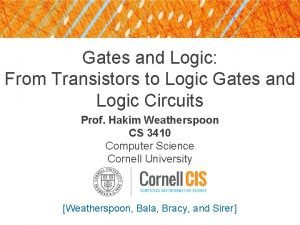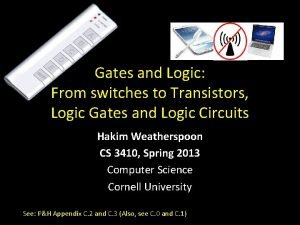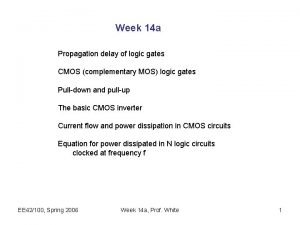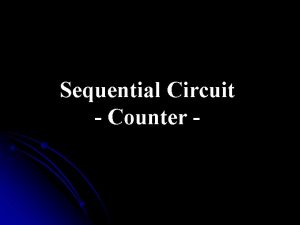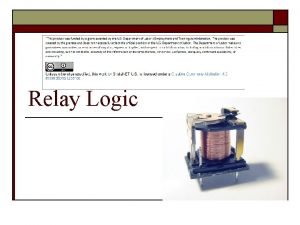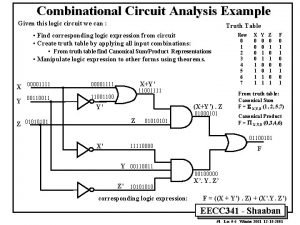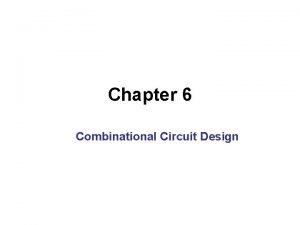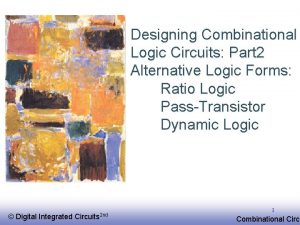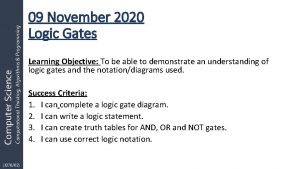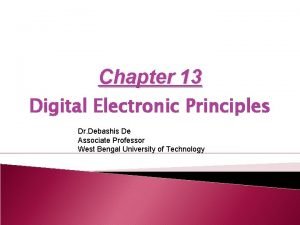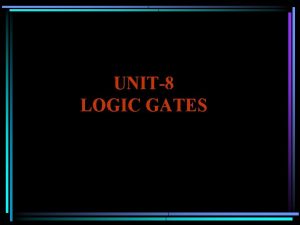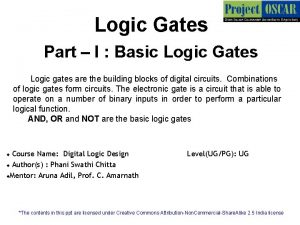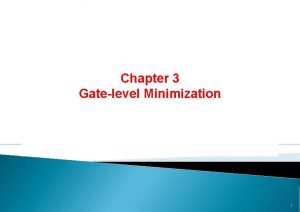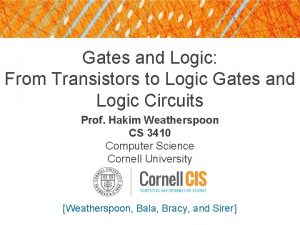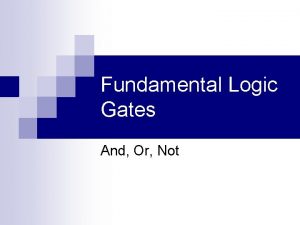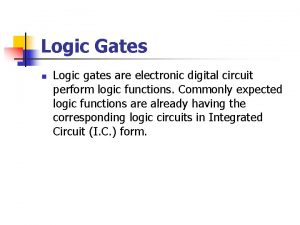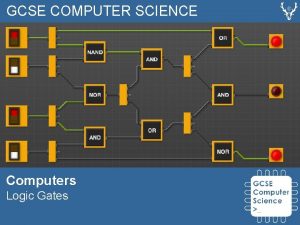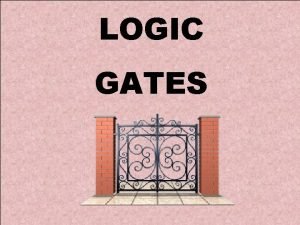UNITIII GATELEVEL DESIGN Topics Logic gates and other





















- Slides: 21

UNIT-III GATELEVEL DESIGN Topics • Logic gates and other complex gates • Switch logic • Alternate gate circuits • Time delays • Driving large capacitive loads • Wiring capacitances • Fan-in and fan-out, Choice of layers 6/3/2015 274

NMOS Gate construction • NMOS devices in series implement a NAND function A • B A B F 0 0 1 1 1 0 A B F 0 0 1 0 1 0 0 1 1 0 • NMOS devices in parallel implement a NOR function A+B A 6/3/2015 B 275

PMOS Gate construction • PMOS devices in parallel implement a NAND function A B A • B A B F 0 0 1 1 1 0 A B F 0 0 1 0 1 0 0 1 1 0 • PMOS devices in series implement a NOR function B A 6/3/2015 A +B 276

Parasitics and Performance • Consider the following layout: • What is the impact on performance of parasitics b – At point a (VDD rail)? – At point b (input)? – At Point c (output)? 6/3/2015 a c 277

Parasitics and Performance • a - power supply connections – capacitance - no effect on delay – resistance - increabses delay (see p. 135) a c • minimize by reducing difffusion length • minimize using parallel vias 6/3/2015 278

Driving Large Loads • Off-chip loads, long wires, etc. have high capacitance • Increasing transistor size increases driving ability (and speed), but in turn increases gate capacitance • Solution: stages of progressively larger transistors – Use nopt = ln(Cbig/Cg). – Scale by a factor of a=e 6/3/2015 281

Summary: Static CMOS • Advantages – – High Noise Margins (VOH=VDD, VOL=Gnd) No static power consumption (except for leakage) Comparable rise and fall times (with proper sizing) Robust and easy to use • Disadvantages – Large transistor counts (2 N transistors for N inputs) • Larger area • More parasitic loading (2 transistor gates on each input) – Pullup issues • Lower driving capability of Ptransistors • Series connections especially problematic • Sizing helps, but increases loading on gate inputs 6/3/2015 282

Alternatives to Static CMOS • • • Switch Logic nmos Pseudo-nmos Dynamic Logic Low-Power Gates 6/3/2015 283

Switch Logic • Key idea: use transistors as switches • Concern: switches are bidirectional A B AND OR 6/3/2015 284

Switch Logic - Pass Transistors • Use n-transistor as “switches” • “Threshold problem” IN: VDD – Transistor switches off when Vgs < Vt – VDD input -> VDD-Vt output OUT: VDD-Vtn A: VDD • “pecial gate needed to “restore” values 6/3/2015 285

Switch Logic - Transmission Gates • • Complementary transistors - n and p No threshold problem Cost: extra transistor, extra control input Not a perfect conductor! A’ A’ A 6/3/2015 A 286

Switch Logic Example - 2 -1 MUX IN 6/3/2015 287

Charge Sharing • Consider transmission gates in series – Each node has parasitic capacitances – Problems occur when inputs change to redistribute charge – Solution: design network so there is always a path from VDD or Gnd to output 6/3/2015 288

Aside: Transmission Gates in Analog • Transmission Gates work with analog values, too! • Example: Voltage-Scaling D/A Converter 6/3/2015 289

NMOS Logic • Used before CMOSwas widely available • Uses only n transistors – Normal n transistors in pulldown network – depletion-mode n transistor (Vt < 0) used for pull-up – "ratioed logic" required • Tradeoffs: – – 6/3/2015 Passive Pullup Device: depletion Mode n-transistor (Vt < 0) OUT Pulldown Network Simpler processing Smaller gates higher power! Additional design considerations for ratioed logic 290

Pseudo-nmos Logic • Same idea, as nmos, but use ptransistor for pullup • "ratioed logic" required for proper design (more about this next) • Tradeoffs: – Fewer transistors -> smaller gates, esp. for large number of inputs – less capacitative load on gates that drive inputs – larger power consumption – less noise margin (VOL > 0) – additional design considerations due to ratioed logic 6/3/2015 Passive Pullup Device: P-Transistor OUT Pulldown Network 291

Rationed Logic for Pseudo-nmos • Approach: – – Assume VOUT=VOL =0. 25*VDD Assume 1 pulldown transistor is on Equate currents in p, n transistors Solve for ratio between sizes of p, n transistors to get these conditions – Further calculations necessary for series connections Pulldown Network Idp OUT Idn I pn Wp Wn 2 1 1 2 Vgs, n Vtn k' p 2 Vgs, p Vtp Vds, p k' n Ln Lp 2 2 Wp Lp 3. 9 (EQ 3 22) Assu min g V DD 3. 3 V Wn Ln 6/3/2015 (EQ 3 21) 292

DCVS Logic • DCVS- Differential Cascode Voltage Switch • Differential inputs, outputs • Two pulldown networks • Tradeoffs – Lower capacitative loading than static CMOS – No ratioed logic needed – Low static power consumption – More transistors – More signals to route between gates 6/3/2015 OUT A B C OUT’ OUT Pulldown Network OUT’ Pulldown Network A’ B’ C’ 293

Dynamic Logic • Key idea: Two-step operation – precharge - charge CSto logic high – evaluate - conditionally discharge CS Storage Node CS Precharge Signal Pulldown • Control - precharge clock f Storage Capacitance Network B A C Precharge 6/3/2015 Evaluate Precharge 294

Domino Logic • Key idea: dynamic gate + inverter • Cascaded gates - “monotonically increasing” CS Pulldown Network B C in 4 x 1 x 2 x 3 6/3/2015 295

Domino Logic Tradeoffs • • Fewer transistors -> smaller gates Lower power consumption than pseudo-nmos Clocking required Logic not complete (AND, OR, but no NOT) 6/3/2015 296
 Xor gate timing diagram
Xor gate timing diagram Logic gates truth tables
Logic gates truth tables Logic gates and truth tables
Logic gates and truth tables Python logic gates
Python logic gates Logic gates and
Logic gates and Propagation delay formula
Propagation delay formula Parking counter using logic gates
Parking counter using logic gates Nand gate with relays
Nand gate with relays Combinational logic gates truth tables
Combinational logic gates truth tables Compound logic gates
Compound logic gates Minecraft or gate
Minecraft or gate Combining logic gates
Combining logic gates Xkcd logic gates
Xkcd logic gates Logic gates truth table quiz
Logic gates truth table quiz Alternative logic gates
Alternative logic gates Logic gates identities
Logic gates identities Processor logic gates
Processor logic gates Application of logic gates in aircraft
Application of logic gates in aircraft For complex gate design in cmos or
For complex gate design in cmos or Logic gates representation
Logic gates representation Computer activity
Computer activity Characteristics of logic gates
Characteristics of logic gates

